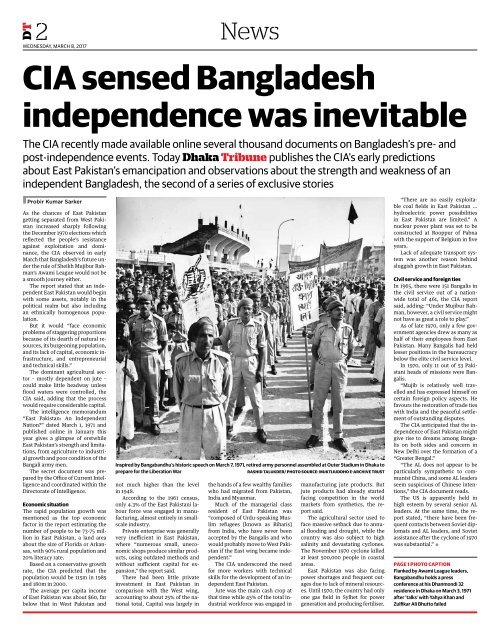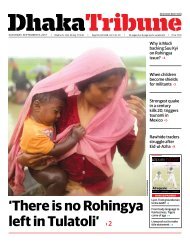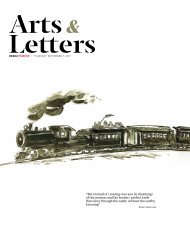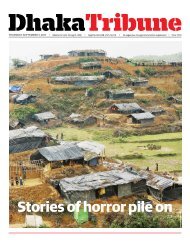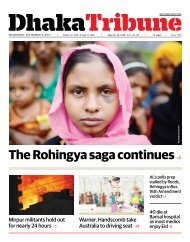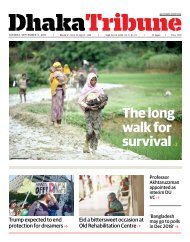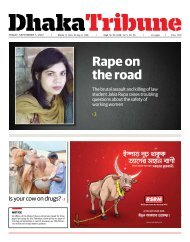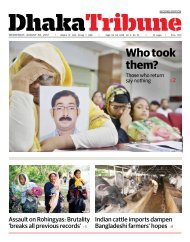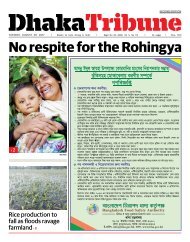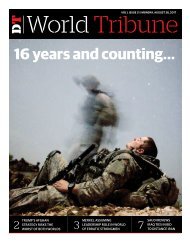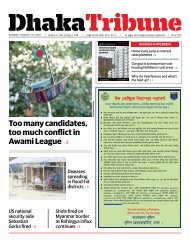DT e-Paper 08 March 2017
You also want an ePaper? Increase the reach of your titles
YUMPU automatically turns print PDFs into web optimized ePapers that Google loves.
2<br />
WEDNESDAY, MARCH 8, <strong>2017</strong><br />
<strong>DT</strong><br />
News<br />
CIA sensed Bangladesh<br />
independence was inevitable<br />
The CIA recently made available online several thousand documents on Bangladesh’s pre- and<br />
post-independence events. Today Dhaka Tribune publishes the CIA’s early predictions<br />
about East Pakistan’s emancipation and observations about the strength and weakness of an<br />
independent Bangladesh, the second of a series of exclusive stories<br />
• Probir Kumar Sarker<br />
As the chances of East Pakistan<br />
getting separated from West Pakistan<br />
increased sharply following<br />
the December 1970 elections which<br />
reflected the people’s resistance<br />
against exploitation and dominance,<br />
the CIA observed in early<br />
<strong>March</strong> that Bangladesh’s future under<br />
the rule of Sheikh Mujibur Rahman’s<br />
Awami League would not be<br />
a smooth journey either.<br />
The report stated that an independent<br />
East Pakistan would begin<br />
with some assets, notably in the<br />
political realm but also including<br />
an ethnically homogenous population.<br />
But it would “face economic<br />
problems of staggering proportions<br />
because of its dearth of natural resources,<br />
its burgeoning population,<br />
and its lack of capital, economic infrastructure,<br />
and entrepreneurial<br />
and technical skills.”<br />
The dominant agricultural sector<br />
– mostly dependent on jute –<br />
could make little headway unless<br />
flood waters were controlled, the<br />
CIA said, adding that the process<br />
would require considerable capital.<br />
The intelligence memorandum<br />
“East Pakistan: An Independent<br />
Nation?” dated <strong>March</strong> 1, 1971 and<br />
published online in January this<br />
year gives a glimpse of erstwhile<br />
East Pakistan’s strength and limitations,<br />
from agriculture to industrial<br />
growth and poor condition of the<br />
Bangali army men.<br />
The secret document was prepared<br />
by the Office of Current Intelligence<br />
and coordinated within the<br />
Directorate of Intelligence.<br />
Economic situation<br />
The rapid population growth was<br />
mentioned as the top economic<br />
factor in the report estimating the<br />
number of people to be 73-75 million<br />
in East Pakistan, a land area<br />
about the size of Florida or Arkansas,<br />
with 90% rural population and<br />
20% literacy rate.<br />
Based on a conservative growth<br />
rate, the CIA predicted that the<br />
population would be 115m in 1985<br />
and 180m in 2000.<br />
The average per capita income<br />
of East Pakistan was about $60, far<br />
below that in West Pakistan and<br />
Inspired by Bangabandhu’s historic speech on <strong>March</strong> 7, 1971, retired army personnel assembled at Outer Stadium in Dhaka to<br />
prepare for the Liberation War<br />
RASHID TALUKDER/ PHOTO SOURCE: MUKTIJUDDHO E-ARCHIVE TRUST<br />
not much higher than the level<br />
in 1948.<br />
According to the 1961 census,<br />
only 4.3% of the East Pakistani labour<br />
force was engaged in manufacturing,<br />
almost entirely in smallscale<br />
industry.<br />
Private enterprise was generally<br />
very inefficient in East Pakistan,<br />
where “numerous small, uneconomic<br />
shops produce similar products,<br />
using outdated methods and<br />
without sufficient capital for expansion,”<br />
the report said.<br />
There had been little private<br />
investment in East Pakistan in<br />
comparison with the West wing,<br />
accounting to about 25% of the national<br />
total. Capital was largely in<br />
the hands of a few wealthy families<br />
who had migrated from Pakistan,<br />
India and Myanmar.<br />
Much of the managerial class<br />
resident of East Pakistan was<br />
“composed of Urdu-speaking Muslim<br />
refugees [known as Biharis]<br />
from India, who have never been<br />
accepted by the Bangalis and who<br />
would probably move to West Pakistan<br />
if the East wing became independent.”<br />
The CIA underscored the need<br />
for more workers with technical<br />
skills for the development of an independent<br />
East Pakistan.<br />
Jute was the main cash crop at<br />
that time while 45% of the total industrial<br />
workforce was engaged in<br />
manufacturing jute products. But<br />
jute products had already started<br />
facing competition in the world<br />
markets from synthetics, the report<br />
said.<br />
The agricultural sector used to<br />
face massive setback due to annual<br />
flooding and drought, while the<br />
country was also subject to high<br />
salinity and devastating cyclones.<br />
The November 1970 cyclone killed<br />
at least 500,000 people in coastal<br />
areas.<br />
East Pakistan was also facing<br />
power shortages and frequent outages<br />
due to lack of mineral resources.<br />
Until 1970, the country had only<br />
one gas field in Sylhet for power<br />
generation and producing fertiliser.<br />
“There are no easily exploitable<br />
coal fields in East Pakistan …<br />
hydroelectric power possibilities<br />
in East Pakistan are limited.” A<br />
nuclear power plant was set to be<br />
constructed at Rooppur of Pabna<br />
with the support of Belgium in five<br />
years.<br />
Lack of adequate transport system<br />
was another reason behind<br />
sluggish growth in East Pakistan.<br />
Civil service and foreign ties<br />
In 1965, there were 151 Bangalis in<br />
the civil service out of a nationwide<br />
total of 461, the CIA report<br />
said, adding: “Under Mujibur Rahman,<br />
however, a civil service might<br />
not have as great a role to play.”<br />
As of late 1970, only a few government<br />
agencies drew as many as<br />
half of their employees from East<br />
Pakistan. Many Bangalis had held<br />
lesser positions in the bureaucracy<br />
below the elite civil service level.<br />
In 1970, only 11 out of 53 Pakistani<br />
heads of missions were Bangalis.<br />
“Mujib is relatively well travelled<br />
and has expressed himself on<br />
certain foreign policy aspects. He<br />
favours the restoration of trade ties<br />
with India and the peaceful settlement<br />
of outstanding disputes.<br />
The CIA anticipated that the independence<br />
of East Pakistan might<br />
give rise to dreams among Bangalis<br />
on both sides and concern in<br />
New Delhi over the formation of a<br />
“Greater Bengal.”<br />
“The AL does not appear to be<br />
particularly sympathetic to communist<br />
China, and some AL leaders<br />
seem suspicious of Chinese intentions,”<br />
the CIA document reads.<br />
The US is apparently held in<br />
high esteem by several senior AL<br />
leaders. At the same time, the report<br />
stated, “there have been frequent<br />
contacts between Soviet diplomats<br />
and AL leaders, and Soviet<br />
assistance after the cyclone of 1970<br />
was substantial.” •<br />
PAGE 1 PHOTO CAPTION<br />
Flanked by Awami League leaders,<br />
Bangabandhu holds a press<br />
conference at his Dhanmondi 32<br />
residence in Dhaka on <strong>March</strong> 3, 1971<br />
after ‘talks’ with Yahya Khan and<br />
Zulfikar Ali Bhutto failed


